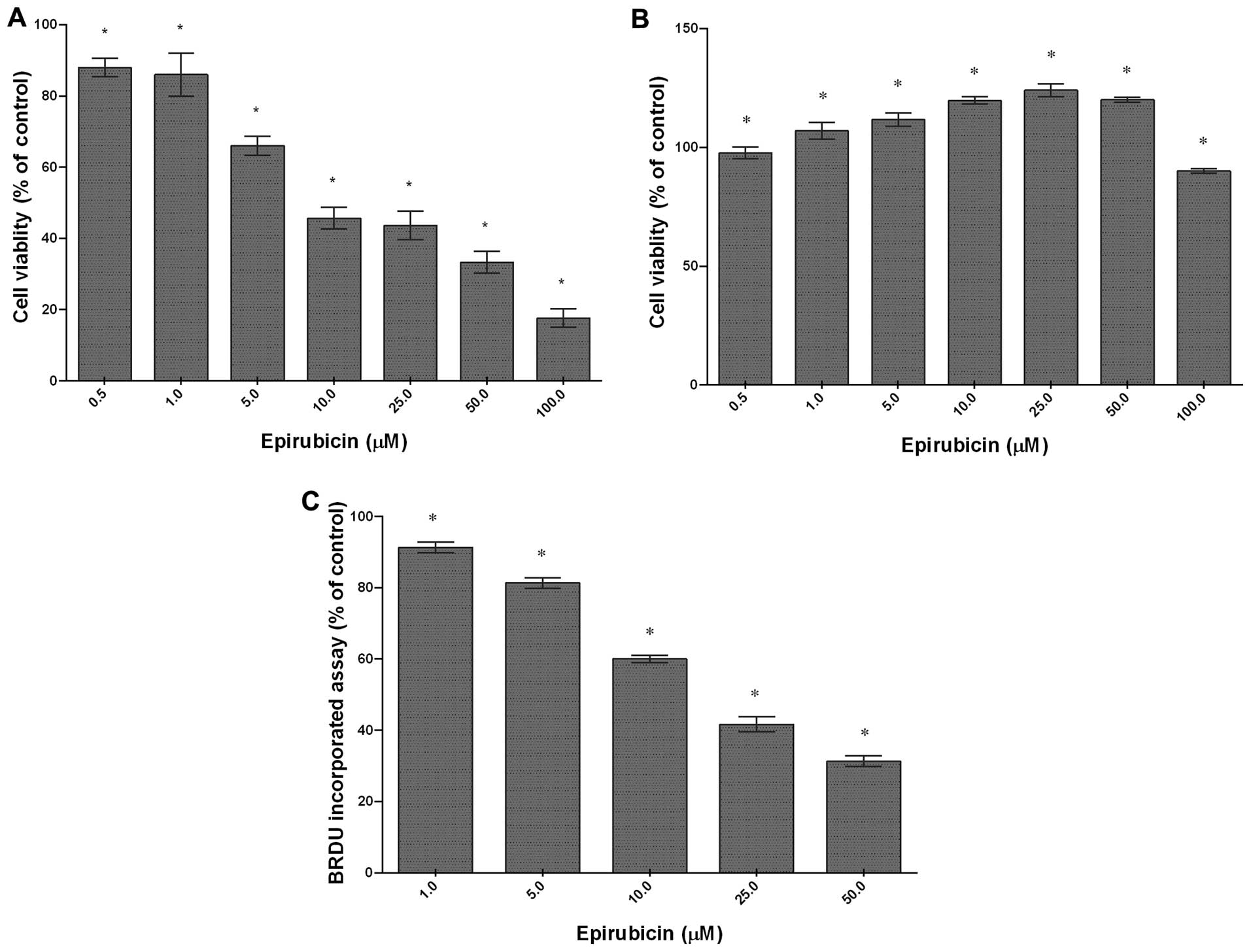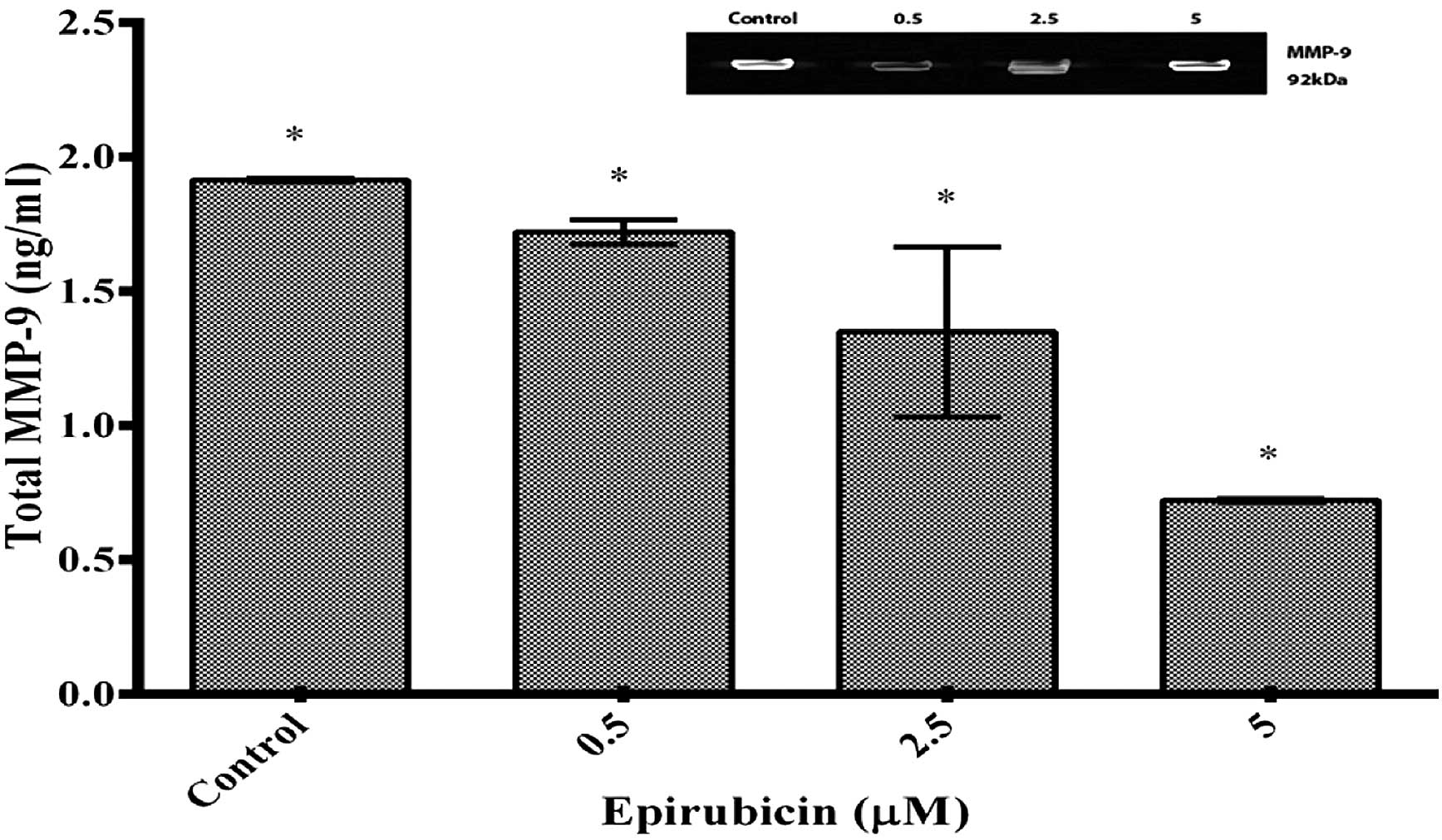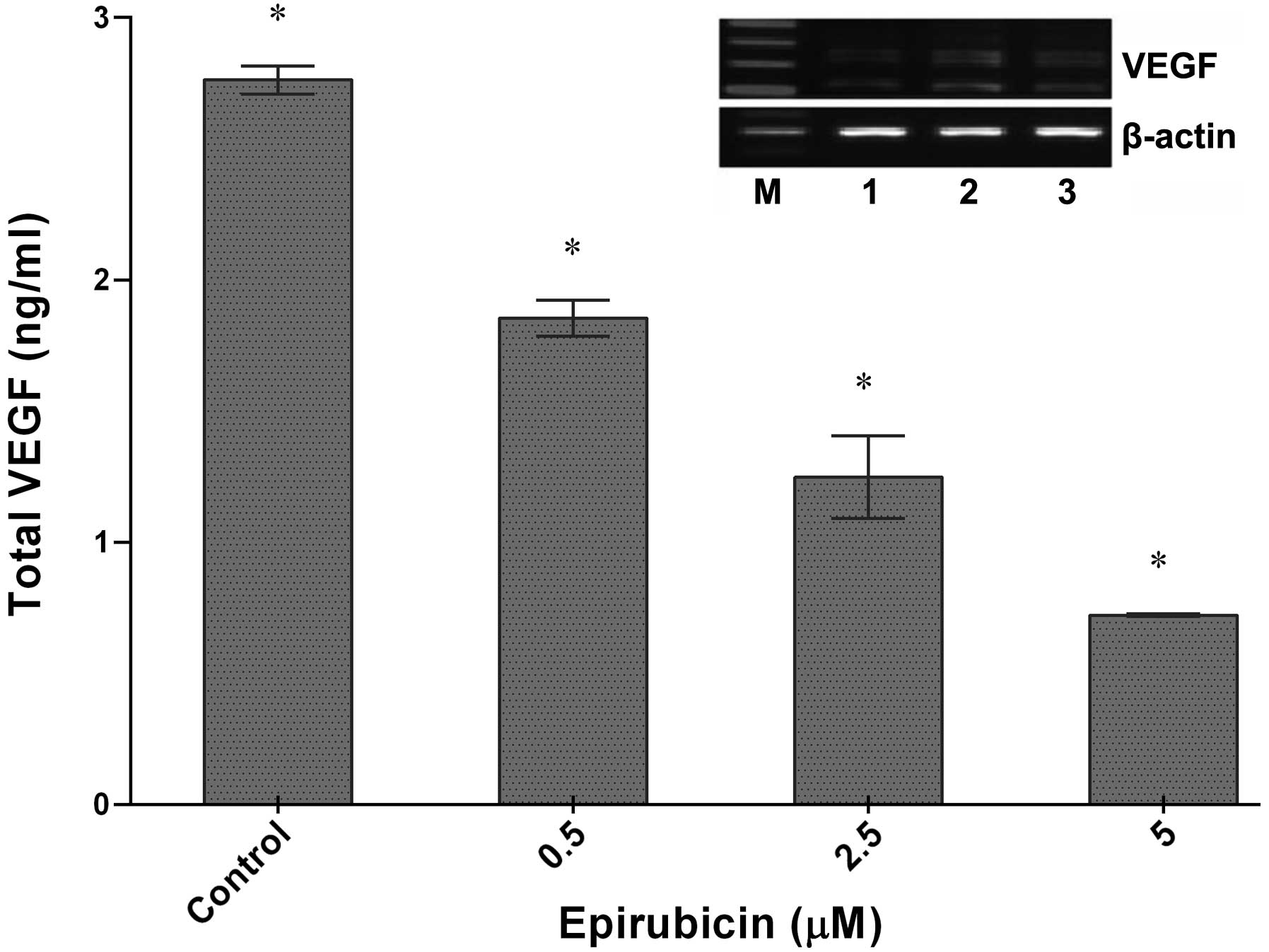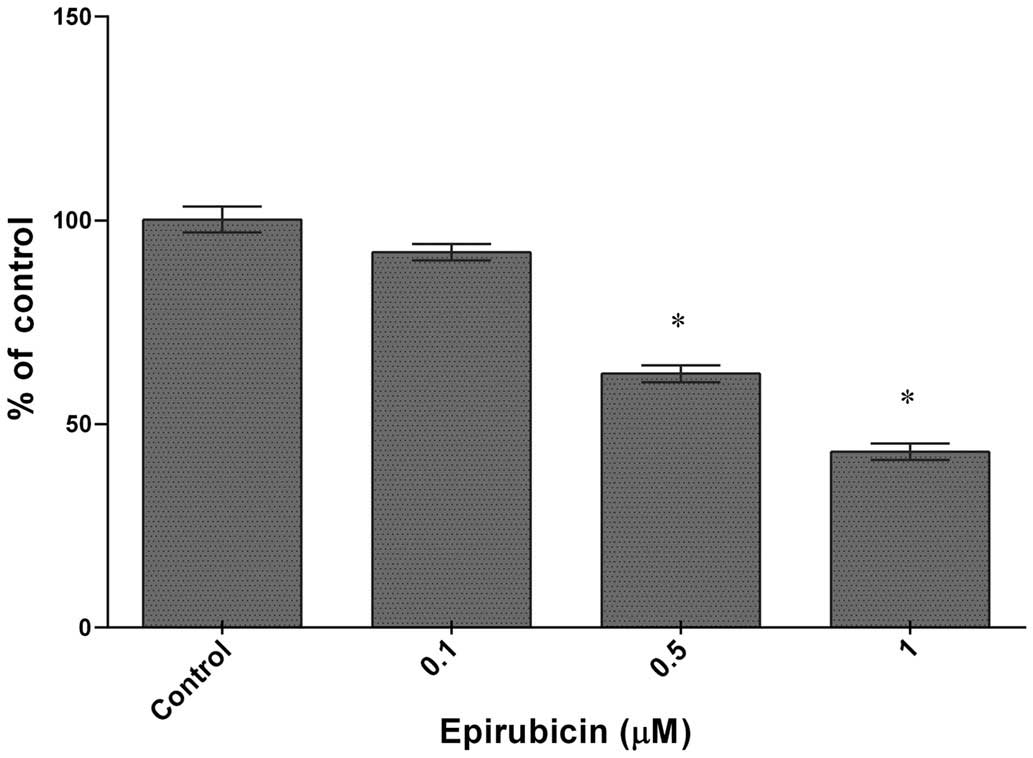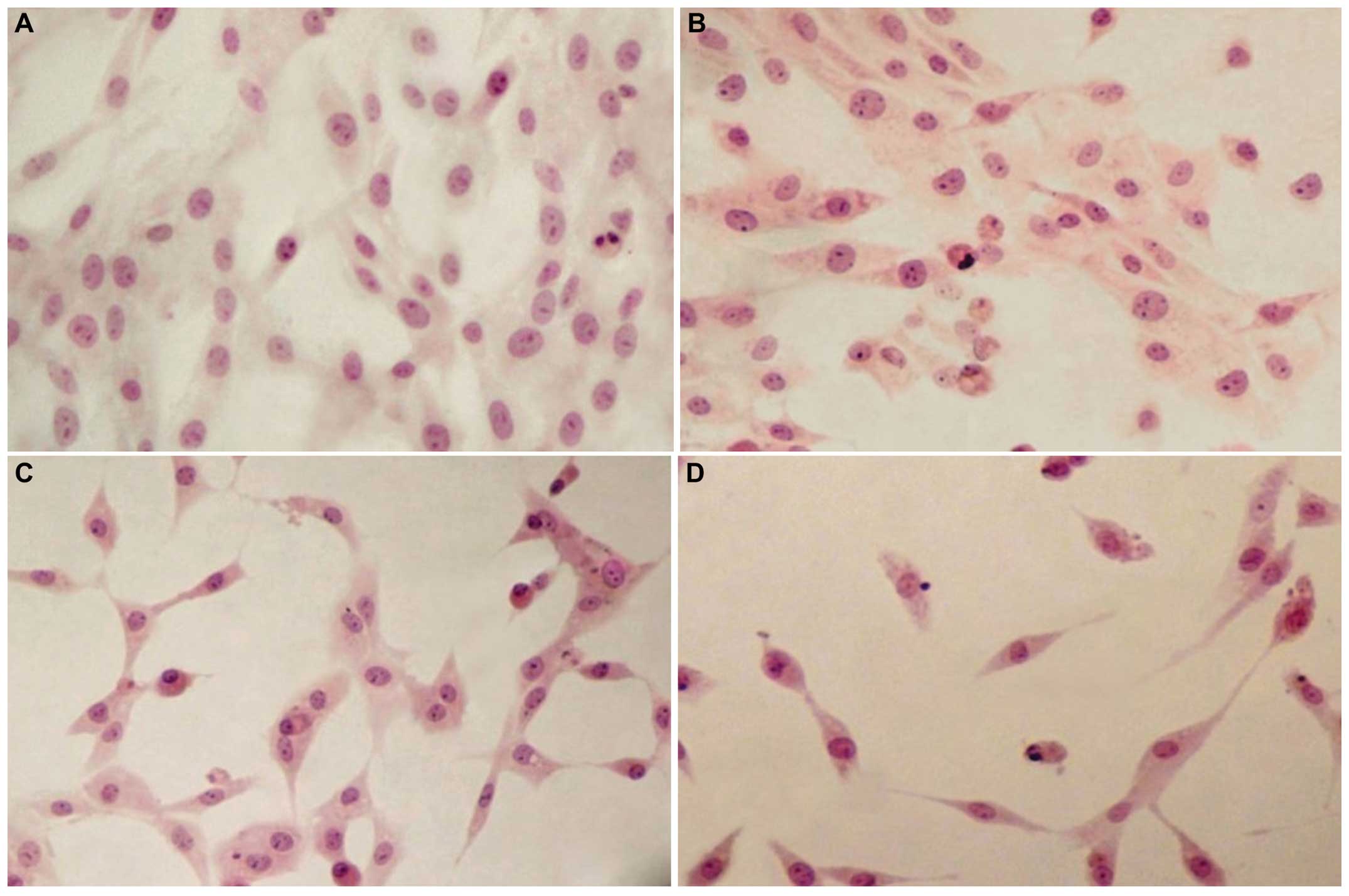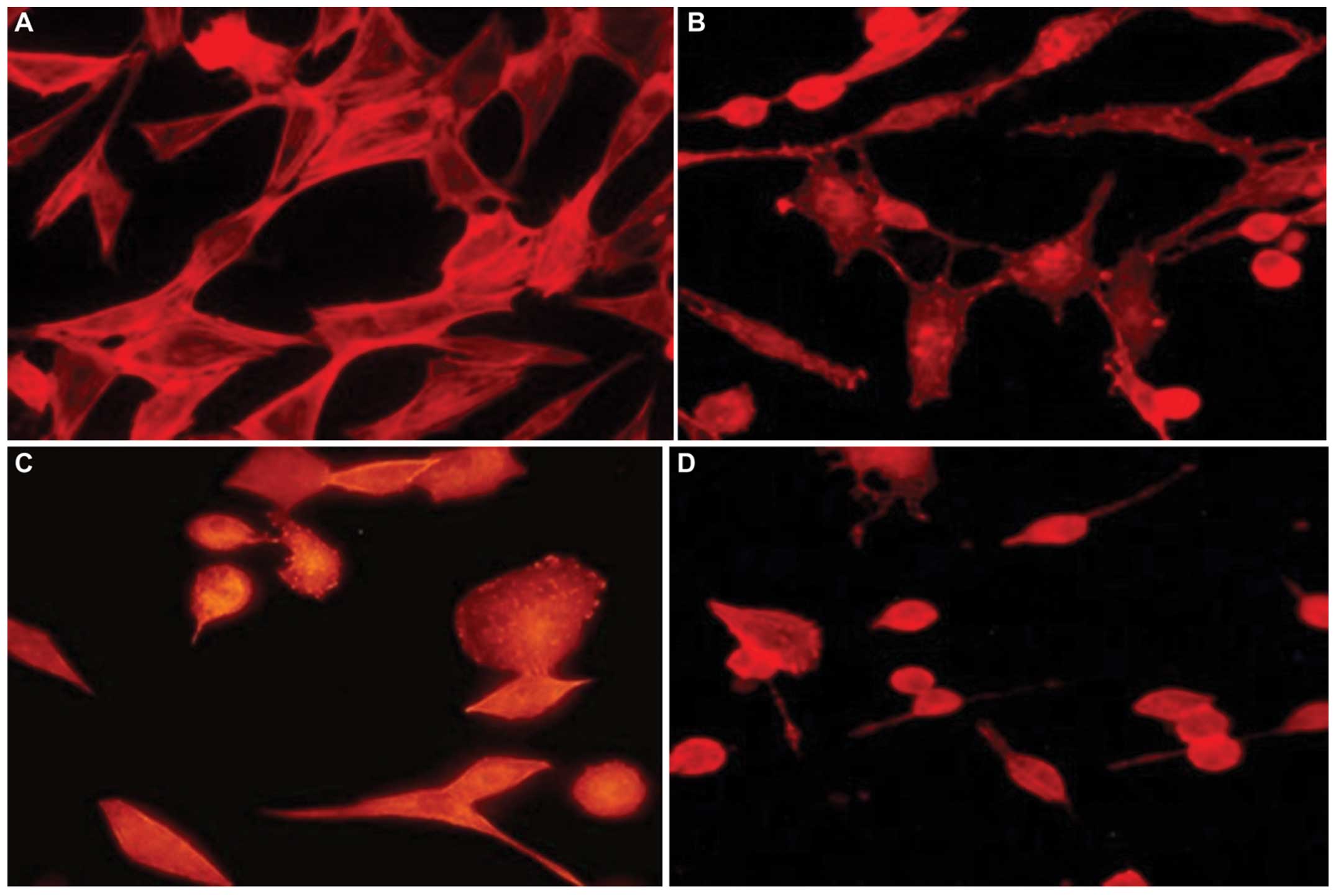Epirubicin inhibits growth and alters the malignant phenotype of the U‑87 glioma cell line
- Authors:
- Published online on: August 12, 2015 https://doi.org/10.3892/mmr.2015.4220
- Pages: 5917-5923
Abstract
Introduction
Gliomas are the most common primary tumors of the central neural system (CNS), accounting for 31% of all CNS tumors and 80% of malignant brain tumors in the United States (1). Depending on their severity, glial tumors are graded from I (benign) to IV (highly malignant) (2). In general, low-grade tumors tend to evolve into high-grade glioblastoma multiforme. However, irrespective of their grading, primary glial tumors almost invariably display marked infiltrative growth characteristics, and glioblastoma cells are able to move from the central part of the tumor far into the surrounding normal brain tissue (3). Cytogenetic studies on glioma cell lines have shown that they follow an evolutionary pattern in vitro, having a tendency toward polyploidization and S karyotype instability. However, these progressive changes appear to not occur randomly (4). The infiltrative nature of high-grade glioma is largely responsible the morbidity and mortality associated with this tumor type (5). Surgical debulking of the tumor may delay its growth but is inadequate for treatment, as microscopically small infiltrated tumor foci lead to eventual recurrence, often in areas that are surgically inaccessible (6–8). Therefore, patients with high-grade gliomas face a poor prognosis with <10% of patients surviving for >2 years. This poor outcome emphasizes the requirement for the enhancement of the understanding of the underlying mechanisms of glioma invasion, as this may contribute to the recognition of novel targets for the therapy of high-grade gliomas (9–11).
Glial tumors are characterized by high proliferation, aggressive behavior and drug resistance. In spite of the current therapeutic options, including surgery, chemotherapy, radiation therapy or other novel modalities, the average survival of patients still remains short. Thus, novel drugs are constantly sought after to improve the treatment effects of patients with malignant gliomas (12–14). Glial tumors are markedly aggressive in a locally invasive fashion. The goal of surgical resection is to remove the gadolinium contrast-enhancing component of the tumor, given the potential morbidity of removing adjacent non-enhancing normal neuronal tissue. However, following all cases of glioblastoma resection, non-contrast-enhancing infiltrative tumor cells remain, which are located away from the main neoplasm. These invasive tumor cells are responsible for recurrence and, ultimately, the demise of patients with glioblastoma, despite radiation therapy and chemotherapy. Recently, glioblastoma stem cells (GSCs), which are a sub-population of glioblastoma cells, have been demonstrated to be integral to tumor growth and perpetuation (9,15,16).
Anthracyclines are important anti-tumor agents used in the treatment of solid tumors, lymphomas and acute lymphoblastic as well as myelocytic leukemias. The clinical utility of agents, including doxorubicin and daunorubicin, and their well-characterized cardiotoxicity have prompted numerous efforts to develop analogs that retain the desired spectrum of activity while being less cardiotoxic (17). Epirubicin (4′-epidoxorubicin) is an anti-neoplastic agent derived from doxorubicin. The compounds differ in the configuration of the hydroxyl group at the 4′ position. Epirubicin, like doxorubicin, exerts its anti-tumor effects by interfering with the synthesis and function of DNA and is most active during the S phase of the cell cycle (18). It acts by intercalating into DNA strands, resulting in complex formation, which inhibits DNA and RNA syntheses. It also triggers DNA cleavage by topoisomerase II, and the generation of oxygen free radicals, resulting in the activation of mechanisms that lead to cell death. These mechanisms are also implicated in the cardiac toxicity of doxurubicin and other anthracyclines (19). Epirubicin has been clinically applied in treating breast cancer, non-Hodgkin's lymphomas, ovarian cancer, soft-tissue sarcomas, pancreatic cancer, gastric cancer, small-cell lung cancer and acute leukemia. As compared to doxorubicin, epirubicin shows less hematologic or myocardial toxicity at comparable doses (20). Epirubicin is among the most active single agents used in the management of patients with breast cancer. The drug may be administered alone or in combination with other agents in patients with early breast cancer and those with metastatic disease (21).
The rapid infiltrative growth of malignant brain glioma severely destroys normal brain tissue (22). A study has indicated that most chemotherapeutic drugs are not active against glioblastoma due to restricted access to the brain tumor site after systemic administration. To achieve therapeutically effective drug levels in the brain, significantly higher doses of these drugs require to be administered, therefore resulting in severe local and systemic toxicities (23). The use of anthracyclines in the treatment of soft tissue sarcomas in adults is well recognized and substantive. At the end of the 1980s, it was first proven that high doses of anthracyclines, compared with standard drugs, were able to yield improved response rates (24), and they are therefore used in modern clinical settings.
The aim of the present study was to verify that epirubicin alters the growth, migration and morphological characteristics of U-87 glioma cells, and to investigate the underlying molecular mechanisms.
Materials and methods
Cell lines and culture conditions
The human glioma cell line U-87 was received from the American Type Culture Collection (Manassas, VA, USA). The primary neuronal cells were isolated as described previously (25). The cells were cultured in a standard tissue culture incubator (37°C; 5% CO2; 95% air; 100% humidity). All tissue culture plastic dishes and flasks were from Nunc (Roskilde, Denmark). Cells were regularly passaged by treatment with trypsin (0.05%) and were grown in Eagle's minimum essential medium (EMEM) supplemented with 10% fetal bovine serum (FBS), penicillin and streptomycin, non-essential amino acids, 1 mg/ml glucose and 1 mM pyruvate (Gibco-BRL, Invitrogen Life Technologies, Carlsbad, CA, USA).
Cell viability assay
The U-87 and neuronal cells were plated on 96-well flat-bottomed microplates at a density of 1×104 cells/well in 100 μl complete growth medium. Prior to drug treatment, the growth medium was substituted with fresh medium containing 2% FBS. The U-87 and neuronal cells were exposed to epirubicin at concentrations of 0.5–100 μM. After 48 h of incubation at 37°C in a humidified atmosphere of 5% CO2, the cytotoxic effect of epirubicin was estimated using an MTT assay. Briefly, the cells were incubated for 3 h with MTT solution (5 mg/ml; Sigma-Aldrich, St Louis, MO, USA). MTT was metabolized by viable cells to purple formazan crystals, which were solubilized overnight in SDS buffer (10% SDS in 0.01 N HCl) and the reaction product was quantified spectrophotometrically by measuring absorbance at 570 nm using an Multiskan MK3 microplate reader (Fisher Thermo Scientific, Waltham, MA, USA). The absorbance of the control wells was set as 100% and the results were expressed as the percentage of the control.
Bromodeoxyuridine (BRDU) cell proliferation assay
DNA synthesis in proliferating cells was evaluated by measuring Bromodeoxyuridine (BRDU) incorporation using a commercial Cell Proliferation ELISA System (11669915001; Roche Diagnostics, Basel Switzerland). The U-87 cells were seeded into 96-well microplates at a density of 1×104 cells/ml in a proliferation medium containing 10% FBS. On the following day, the medium was replaced and the cells were exposed to 1–50 μM epirubicin for 48 h. Subsequently, the cells were incubated for 2 h with a BRDU labeling solution containing 10 μM BRDU. The assay was performed according to the manufacturer's instructions. The optical density values were evaluated at 450 nm using an ELISA reader. The culture medium alone was applied as a control for non-specific binding.
Western blot analysis
The U-87 cells were grown in six-well plates (3×105 cells/ml with 3 ml/well) in a medium containing 10% FBS for 24 h at 37°C. On the following day, the medium was replaced with fresh 2% FBS-EMEM and the cells were treated with epirubicin at concentrations of 1, 5 or 10 μM. After 24 h of incubation, the cells were washed in cold phosphate-buffered saline (PBS) and lysed in radioimmunoprecipitation assay buffer [containing 50 μM Tris-HCl (pH 7.4), 150 mM NaCl, 1% sodium deoxycholate, 0.1% SDS, 10 mM NaF, 1 mM sodium orthovanadate, 1 mM EDTA, 1% Triton X-100 and protease inhibitor cocktail] at 4°C for 30 min. In parallel, the lysates were centrifuged at 10,000 ×g for 15 min at 4°C. Laemmli buffer was added to 50 mg sample and the mixture was boiled for 5 min, followed by separation using 9% SDS-PAGE. The proteins were transferred onto an Immobilon P membrane (Merck, Darmstadt, Germany). After the transfer, the membrane was blocked with blocking buffer (5% non-fat dried milk in Tris-buffered saline/0.1% Tween 20) for 1 h at room temperature and then examined with appropriate dilutions of primary antibodies from the Cell Proliferation ELISA and VEGF Enzyme Immunoassay (KHG0111; Strathmann Biotec, Hamburg, Germany) kits overnight at 4°C. The membranes were washed three times for 10 min with PBS containing 0.05% Triton X-100 and incubated for 1 h with horseradish peroxidase-labelled anti-mouse antibody. The membranes were visualized using Western Blot Chemiluminescence Reagent (Amersham Biosciences, Amersham, UK) using Kodak Biomax film (Kodak, Rochester, NY, USA). The blots were re-probed with antibodies against β-actin to ensure equal loading and transport of proteins.
Determination of matrix metalloproteinase (MMP)-9 and vascular endothelial growth factor (VEGF) concentration by ELISA
MMP-9 levels in the conditioned media of the U-87 cells were determined using a commercial human MMP-9 immunoassay kit (RayBiotec, Norcross, GA, USA), and VEGF protein released into the conditioned medium was assessed using the VEGF Enzyme Immunoassay kit. The U-87 cells (3×105 cells/ml) were seeded in 24-well plates with 1 ml EMEM containing 10% FBS and incubated for 24 h. The growth medium was then replaced with EMEM containing 2% FBS and the U-87 cells were treated with epirubicin (0.5, 2.5 or 5 μM). After 48 h of incubation, the culture medium was collected, centrifuged and immediately frozen at −80°C until quantification of MMP-9 or VEGF using the kits according to the manufacturer's instructions.
Cell migration (wound healing) assay
Tumor cell migration was assessed using the wound healing assay. Tumor cells were plated at 1×106 cells on 4-cm culture dishes (Nunc). The cell monolayer was scratched with a pipette tip (P300) and the plates were rinsed twice with PBS to wash off the dislodged cells. Next, epirubicin dilutions in fresh medium (0.1–1 μM) supplemented with 2% FBS were applied and the number of cells migrated into the wound area after 24 h was estimated and compared to that in control cultures. Plates were stained using the May-Grunwald-Giemsa method and observed using an Olympus BX51 System microscope (Olympus, Tokyo, Japan). Results are expressed as the percentage of the number of cells migrated into the wound area compared with that in the control group.
Assessment of morphological changes and cytoskeleton staining
The U-87 cells (5±104 cells/ml) were grown in Leighton tubes containing rectangular glass coverslips for 24 h. The medium was replaced with fresh medium containing 2% FBS and different concentrations of epirubicin (1, 5 or 10 μM), and the cells were incubated for 48 h at 37°C. Control cells were cultured in medium without epirubicin. After the treatment, the cells were fixed and stained according to the standard hematoxylin-eosin (Poly Scientific R&D Corp., Bayshore, NY, USA) method. Observation was performed under the Olympus BX51 System microscope and the micrographs were processed using analySiS software, version 5.0 (Soft Imaging System GmbH, Münster, Germany). Part of the cell samples were fixed in a 3% formaldehyde solution in PBS, (pH 7.4), for 30 min at room temperature, incubated with 0.5% Triton X-100 in PBS for 15 min at room temperature, blocked in PBS containing 3% bovine serum albumin (BSA; Sigma-Aldrich) for 1 h at room temperature and incubated with tetramethylrhodamine-labeled phalloidin (0.5 mg/ml) in PBS for 1 h at room temperature in the dark. Representative fluorescence micrographs of these cells were captured using the Olympus BX51 System microscope.
Statistical analysis
Values are expressed as the mean ± standard error. Statistical analyses were performed using GraphPAD Prism 5 (GraphPAD Software Inc., La Jolla, CA, USA). The data were analyzed by one-way analysis of variance, followed by Dunnett's test. P<0.01 was considered to indicate a statistically significant difference between values.
Results
Selective cytotoxic and anti-proliferative effects of epirubicin
The cytotoxic effect of epirubicin was determined in the U-87 glioma cells and neuronal primary culture by using an MTT cell viability assay. Epirubicin significantly decreased the viability of rat U-87 cells in a concentration-dependent manner with an IC50 of 6.3 μM (Fig. 1A). At the highest concentration used (100 μM), epirubicin reduced cell viability to approximately 14% in comparison to that of the control. In contrast to the U-87 glioma cells, the rat normal neuronal cells were resistant to epirubicin. When they were incubated with epirubicin at 1–50 μM, the number of live cells in the cultures was markedly higher compared with that of untreated cells (Fig. 1B). These results clearly indicate selective, dose-dependent cytotoxicity of epirubicin against tumor cells. To examine the anti-proliferative potential of epirubicin, the U-87 glioma cells were treated with 1, 5, 10, 25 or 50 μM epirubicin for 48 h and the BRDU assay was performed. Epirubicin effectively reduced BRDU incorporation during DNA synthesis (Fig. 1C). A significant decrease in cell division was found even at 1 μM. The most pronounced effect was observed following treatment with 50 μM epirubicin, which suppressed proliferation of the U-87 cells by 70%. These results were in agreement with the results of the MTT cell viability assay and indicated a dose-dependent anti-proliferative activity of epirubicin in the cells examined.
Epirubicin decreases MMP-9 secretion by U-87 cells
The most pronounced inhibitory effect on MMP-9 secretion was detected at the epirubicin concentration of 5 μM according to the ELISA assay. As shown in Fig. 2, epirubicin reduced the capacity of the U-87 cells to secrete total MMP-9 after 48-h incubation in a dose-dependent manner. The amount of MMP-9 released into the culture medium after the treatment with epirubicin at the concentrations of 2.5 and 5 mM was reduced by 1.43±2.1 and 0.7±1.3 ng/ml, respectively, compared with that in the control.
Epirubicin markedly reduces secretion of VEGF by U-87 glioma cells
The effect of epirubicin on VEGF release into the U-87 culture medium was quantified by ELISA. There is a demand for novel chemotherapeutics targeting VEGF and they are promising to be potent (26), as VEGFs have a significant role in angiogenesis and lymphangiogenesis (27). As indicated in Fig. 3, VEGF secretion of U-87 cells was markedly decreased following treatment of the cells with increasing epirubicin concentrations. After 48 h of incubation of the U-87 cells with epirubicin, the VEGF levels were diminished from 2.56 ng/ml (untreated cells) to 1.22 ng/ml and 0.80 ng/ml at 2.5 μM and 5 μM epirubicin, respectively.
Epirubicin inhibits the migration of U-87 cells
The influence of epirubicin on cell migration was estimated using a wound healing assay. As shown in Fig. 4, epirubicin caused a significant decrease in cell migration ranging from 28% at 0.1 μM to ~59% when the cells were exposed to 1 μM of epirubicin (IC50=0.5 μM).
Epirubicin alters the morphology and the cytoskeletal assemblyof U-87 cells
To assess the effect of epirubicin on cell morphology, the treated cells were stained with hematoxylin-eosin and observed under a light microscope. The morphological study revealed that the control cells had a fibroblastic or dendritic-like morphology with abundant cytoplasm and presented extensive prolongations. Their nuclei were round with a vast number of nucleoli (Fig. 5A). The untreated cells also demonstrated a high proliferative activity, as a number of them underwent mitotic division. The cells exposed to 1 or 5 μM epirubicin for 48 h showed typical features of late apoptosis, including shrinkage and chromatin condensation (Fig. 5B and C). The most marked morphological alterations were noted at a concentration of 10 μM epirubicin (Fig. 5D). In this group, the cells were rounded and shrunken, with irregular and pycnotic nuclei and a reduced length of cytoplasmic protrusions. In this group, the number of vacuolized, non-proliferating and detached cells was also markedly higher in comparison to those in the groups exposed to the lower dosages of epirubicin. These findings suggested that epirubicin effectively induced apoptosis in glioma cells.
In order to study the constitution of the actin cytoskeleton, the control and treated cells were stained using rhodamine-labelled phalloidin and visualized under a fluorescence microscope. The control cells showed highly organized, dense actin structures extending from the cell surface throughout the cytosol and along broad lamellipodia (Fig. 6A). Direct observation of the U-87 cells exposed to epirubicin for 48 h revealed dose-dependent alterations in actin cytoskeletal organization (Fig. 6B–D). Anthracycline treatment resulted in rapid F-actin depolymerization in the cell body, loss of bundles of actin filaments and stress fibers, as well as suppressed formation of long cellular protrusions. The epirubicin-induced cytoskeletal disruption may have contributed to the structural changes described above.
Discussion
Glioblastoma is the most frequent (65%) and most malignant histological type of CNS tumor in the USA (26). Anthracycline treatment is associated with an increased risk of dose-dependent heart failure, which limits their clinical application. Epirubicin (EPI) has been demonstrated to inhibit tumor cell growth in numerous tumor cell lines and is currently applied to treat solid and hematologic malignancies, including breast cancer (28,29). A study has reported the efficacy of epirubicin in vitro in the C6 glioma cell line (30). In a study by Cantoni et al (31), exposure of a human tumor cell line (HeLa) to epirubicin and doxorubicin for either 1 h or 24 h at a scope of concentrations resulted in greater cytotoxicity of epirubicin over doxorubicin at the 1-h exposure, while the toxicity of the two anthracyclines was similar following 24 h of incubation. The authors linked this to the greater uptake rate of epirubicin and the earlier achievement of cytotoxic levels within the cells, while not excluding other, additional, mechanisms.
The present study showed that epirubicin markedly diminished U-87 cell viability following 48-h exposure. Of note, epirubicin did not kill normal neuronal cells in culture and even increased the activity of mitochondrial dehydrogenase at high concentrations, as indicated by increased rates of formazan production in the MTT assay. Additional investigations are required in order to fully elucidate the mechanisms by which statins mediate distinct effects on neuronal cells. The results of the present study are in line with the results reported by Hershman and Shao (32) as well as O'Shaughnessy et al (33), who reported that anthracyclines decreased cellular proliferation. Cytostatic effects of anthracycline antibiotics resulted from their binding to nucleic acids, which contributes to the inhibition of protein synthesis in cells as reported earlier by Vitvitsky (34). Anthracycline drugs that act as topoisomerase-II inhibitors induce DNA damage in cells. The quinone group of anthracyclines may undergo a one-electron reduction to yield a semiquinone, thus producing free radicals and contributing to cancer formation (35). Malignant cell transformation results in a loss of tyrosine kinase (TK) regulation with spontaneously increased TK activity, even in the absence of external stimuli, resulting in uncontrolled cell reproduction, which is encountered in nearly 70% of tumors (36). Finally, TKs are also involved in tumor angiogenesis, as their stimulation by VEGF, platelet-derived growth factor and transforming growth factor-α promote tumor growth-associated neovascularization. Epidermal growth factor receptor is present in multiple tumor types and enables cancer cell proliferation, invasion and migration (37,38).
It has been recognized that anthracyclines also exert anti-cancer activities through inhibition of factors driving characteristic hallmarks of malignant cells, including fast proliferation, enhanced locomotion, aggressiveness, angiogenesis and dissemination to various sites in the body (39). Thus, the present study assessed which aspects of tumor invasion may be affected by epirubicin. Addition of epirubicin to the culture medium impaired the mobility of U-87 cells as determined by the wound-healing assay. The inhibitory effect was apparent at low concentrations, such as 6.3 μM epirubicin. The processes of cell invasion and metastasis are mediated not only by MMPs, but also by other molecules, including VEGF. VEGF is the most important stimulator of angiogenesis in numerous types of cancer (40,41).
In conclusion, the present study indicated that epirubicin showed anti-proliferative and anti-metastatic activity. The findings further indicated that the VEGF may be an appropriate target to suppress invasive behavior and progression of brain tumor cells as demonstrated using the U-87 cell line. The activity of epirubicin against glioma cells was associated with the alteration of motility and suppression of the secretion of VEGF and MMP-9. These findings indicated that epirubicin is a potential therapeutic agent for the treatment of gliomas; however, further studies are required.
References
|
García-Claver A, Lorente M, Mur P, et al: Gene expression changes associated with erlotinib response in glioma cell lines. Eur J Cancer. 49:1641–1653. 2013. View Article : Google Scholar : PubMed/NCBI | |
|
Kleihues P, Louis DN, Scheithauer BW, et al: The WHO classification of tumors of the nervous system. J Neuropathol Exp Neurol. 61:215–225. 2002.PubMed/NCBI | |
|
de Vries NA, Beijnen JH, Boogerd W and van Tellingen O: Blood-brain barrier and chemotherapeutic treatment of brain tumors. Expert Rev Neurother. 6:1199–1209. 2006. View Article : Google Scholar : PubMed/NCBI | |
|
Mark J, Westermark B, Pontén J and Hugosson R: Banding patterns in human glioma cell lines. Hereditas. 87:243–260. 1977. View Article : Google Scholar : PubMed/NCBI | |
|
Couldwell WT, de Tribolet N, Antel JP, Gauthier T and Kuppner MC: Adhesion molecules and malignant gliomas: implications for tumorigenesis. J Neurosurg. 76:782–791. 1992. View Article : Google Scholar : PubMed/NCBI | |
|
Khong A, Cleaver AL, Alatas MF, Wylie BC, Connor T, Fisher SA, Broomfield S, Lesterhuis WJ, Currie AJ and Lake RA: The efficacy of tumor debulking surgery is improved by adjuvant immunotherapy using imiquimod and anti-CD40. BMC cancer. 14:9692014. View Article : Google Scholar : PubMed/NCBI | |
|
Chao LC, Juan WS, Chang CC, Tai SH, Chuang MT, Sze CI and Lee EJ: Surgical debulking plus adjuvant chemoradiotherapy of a huge basal ganglion nongerminomatous germ cell tumor with long term survival. Int J Pediatr. 2:312014. | |
|
Bush S, Williams H, Aksu C, Rungruang B, Macfee M and Ghamande S: PET probe-assisted surgical debulking in patients with recurrent gynecologic tumors. Gynecol Oncol. 130:e111–e112. 2013. View Article : Google Scholar | |
|
Hochberg FH and Pruitt A: Assumptions in the radiotherapy of glioblastoma. Neurol. 30:907–911. 1980. View Article : Google Scholar | |
|
Berens ME, Rutka JT and Rosenblum ML: Brain tumor epidemiology, growth and invasion. Neurosurg Clin N Am. 1:1–18. 1990.PubMed/NCBI | |
|
Cho KK, Mikkelsen T, Lee YJ, et al: The role of protein kinase Calpha in U-87 glioma invasion. Int J Dev Neurosci. 17:447–461. 1999. View Article : Google Scholar : PubMed/NCBI | |
|
Demuth T and Berens ME: Molecular mechanisms of glioma cell migration and invasion. J Neurooncol. 70:217–228. 2004. View Article : Google Scholar | |
|
Holland EC: Glioblastoma multiforme: the terminator. Proc Natl Acad Sci USA. 97:6242–6254. 2000. View Article : Google Scholar : PubMed/NCBI | |
|
Slawińska-Brych A, Zdzisińska B and Kandefer-Szerszeń M: Fluvastatin inhibits growth and alters the malignant phenotype of the C6 glioma cell line. Pharmacol Rep. 66:121–129. 2014. View Article : Google Scholar | |
|
Hadjipanayis CG and Van Meir EG: Brain cancer propagating cells: biology, genetics and targeted therapies. Trends Mol Med. 15:519–530. 2009. View Article : Google Scholar : PubMed/NCBI | |
|
Hentschel SJ and Lang FF: Current surgical management of glioblastoma. Cancer J. 9:113–125. 2003. View Article : Google Scholar : PubMed/NCBI | |
|
Kuffel MJ, Reid JM and Ames MM: Anthracyclines and their C-13 alcohol metabolites: growth inhibition and DNA damage following incubation with human tumor cells in culture. Cancer Chemother Pharmacol. 30:51–57. 1992. View Article : Google Scholar : PubMed/NCBI | |
|
Cersosimo RJ and Hong WK: Epirubicin: a review of the pharmacology, clinical activity and adverse effects of an adriamycin analogue. J Clin Oncol. 4:425–439. 1986.PubMed/NCBI | |
|
Bonadonna G, Gianni L, Santoro A, Bonfante V, Bidoli P, Casali P, Demicheli R and Valagussa P: Drugs ten years later: epirubicin. Ann Oncol. 4:359–369. 1993.PubMed/NCBI | |
|
Birtle AJ: Anthracyclines and cardiotoxicity. Clin Oncol. 12:146–152. 2000. | |
|
Coukell AJ and Faulds D: Epirubicin. An updated review of its pharmacodynamic and pharmacokinetic properties and therapeutic efficacy in the management of breast cancer. Drugs. 53:453–482. 1997. View Article : Google Scholar : PubMed/NCBI | |
|
Astner ST, Pihusch R, Nieder C, Rachinger W, Lohner H, Tonn JC, Molls M and Grosu AL: Extensive local and systemic therapy in extraneural metastasized glioblastoma multiforme. Anticancer Res. 26:4917–4920. 2006. | |
|
Dhanikula RS, Argaw A, Bouchard JF and Hildgen P: Methotrexate loaded polyether-copolyester dendrimers for the treatment of gliomas: enhanced efficacy and intratumoral transport capability. Mol Pharm. 5:105–116. 2008. View Article : Google Scholar : PubMed/NCBI | |
|
Parney IF and Chang SM: Current chemotherapy for glioblastoma. Cancer J. 9:149–156. 2003. View Article : Google Scholar : PubMed/NCBI | |
|
Reynolds B and Weiss S: Generation of neurons and astrocytes from isolated cells of the adult mammalian central nervous system. Science. 255:1707–1710. 1992. View Article : Google Scholar : PubMed/NCBI | |
|
Ohgaki H and Kleihues P: Epidemiology and etiology of gliomas. Acta Neuropathol. 109:93–108. 2005. View Article : Google Scholar : PubMed/NCBI | |
|
Ferrara N: Vascular endothelial growth factor: basic science and clinical progress. Endocr Rev. 25:581–611. 2004. View Article : Google Scholar : PubMed/NCBI | |
|
Hirano A, Shimizu T, Imamura H, et al: The combination of epirubicin plus docetaxel as neoadjuvant chemotherapy in locally-advanced breast cancer. Anticancer Res. 26:581–584. 2006.PubMed/NCBI | |
|
Tokudome N and Ito Y: Adjuvant chemotherapy based on evidence-based medicine for breast cancer patients. Japan J Cancer Chemother. 33:318–323. 2006.In Japanese. | |
|
Schott B and Robert J: Comparative activity of anthracycline 13-dihydrometabolites against rat glioblastoma cells in culture. Biochem Pharmacol. 38:4069–4074. 1989. View Article : Google Scholar : PubMed/NCBI | |
|
Cantoni O, Sestili P, Cattabeni F, Geroni C and Giuliani F: Comparative effects of doxorubicin and 4′-epi-doxorubicin on nucleic acid metabolism and cytotoxicity in a human tumor cell line. Cancer Chemo Pharmacol. 27:47–5. 1990. View Article : Google Scholar | |
|
Hershman DL and Shao T: Anthracycline cardiotoxicity after breast cancer treatment. Oncology (Williston Park). 23:227–234. 2009. | |
|
O'Shaughnessy J, Twelves C and Aapro M: Treatment for anthracycline-pretreated metastatic breast cancer. Oncologist. 7(Suppl 6): 4–12. 2002. View Article : Google Scholar : PubMed/NCBI | |
|
Vitvitsky VM: Erythrocytes as carriers of anthracycline antibiotics in vitro and in vivo. erythrocyte engineering for drug delivery and targeting. pp. 992002 | |
|
Salvatorelli E, Guarnieri S, Menna P, et al: Defective one- or two-electron reduction of the anticancer anthracycline epirubicin in human heart. Relative importance of vesicular sequestration and impaired efficiency of electron addition. J Biol Chem. 281:10990–11001. 2006. View Article : Google Scholar : PubMed/NCBI | |
|
Dulak J and Józkowicz A: Regulation of vascular endothelial growth factor synthesis by nitric oxide: facts and controversies. Antioxidants and redox signaling. 5:123–132. 2003. View Article : Google Scholar : PubMed/NCBI | |
|
Gerber DE: Targeted therapies: a new generation of cancer treatments. Am Fam Physician. 77:311–319. 2008.PubMed/NCBI | |
|
Mendelsohn J and Baselga J: Epidermal growth factor receptor targeting in cancer. Semin Oncol. 33:369–385. 2006. View Article : Google Scholar : PubMed/NCBI | |
|
Hortobágyi G: Anthracyclines in the treatment of cancer. An overview Drugs. 54(Suppl 4): 1–7. 1997. | |
|
Shibata T, Tamura M, Kabashima N, et al: Fluvastatin attenuates IGF-1-induced ERK1/2 activation and cell proliferation by mevalonic acid depletion in human mesangial cells. Life Sci. 84:725–731. 2009. View Article : Google Scholar : PubMed/NCBI | |
|
Takenaka M, Hirade K, Tanabe K, et al: Simvastatin stimulates VEGF release via p44/p42 MAP kinase in vascular smooth muscle cells. Biochem Biophys Res Commun. 301:198–203. 2003. View Article : Google Scholar : PubMed/NCBI |



